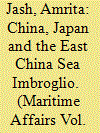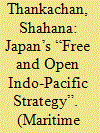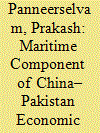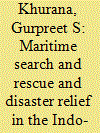|
|
|
Sort Order |
|
|
|
Items / Page
|
|
|
|
|
|
|
| Srl | Item |
| 1 |
ID:
157803


|
|
|
|
|
| Summary/Abstract |
This paper elucidates the changing dynamics of India’s Indian Ocean Policy that substantiates four hypotheses. First, India’s maritime mindset has changed from a territorial to a non-territorial conception of the sea due to change in its strategy of economic development. Second, the evolving geopolitics of the Indian Ocean and India’s power projection aspirations have been driving New Delhi deep into the Indian Ocean. Third, the Chinese attempts to penetrate into the India Ocean through its client states such as Pakistan, Bangladesh, Sri Lanka, Maldives and Myanmar, etc., and its One Belt One Road (OBOR) or Maritime Silk Route (MSR) initiatives, have been posing a real-time maritime security challenge to India’s Indian Ocean strategy. Fourth, the US policy of Rebalance to Asia (RTA) has been providing geopolitical opportunity as well as challenge to India’s power projection drive in the Indian Ocean.
|
|
|
|
|
|
|
|
|
|
|
|
|
|
|
|
| 2 |
ID:
157808


|
|
|
|
|
| Summary/Abstract |
The East China Sea dispute has become a characteristic feature in the defined “hot economics, cold politics” relations between China and Japan. The maritime sphere has gained precedence in the larger realm of diplomacy, thus making the contested waters a primary hotspot of power politics between the two Asian countries. With the growing tensions, in all likelihood the maritime dispute will be high on the political and security agenda of China and Japan. What makes this worrisome is that the dispute does not just make the bilateral relations unstable but holds significant implications for East Asia’s regional stability. In this regard, given the phenomenon of constant testing of each other’s resolve, the possibility of an all-out confrontation in the East China Sea remains a vital concern. What has further added to the power struggle is the US involvement, thus making the dispute a difficult case to resolve. The crux of the paper lies in understanding the volatility of the East China Sea dispute between China and Japan. In doing so, the paper examines the determinants of the dispute, the actors involved and their responses.
|
|
|
|
|
|
|
|
|
|
|
|
|
|
|
|
| 3 |
ID:
157807


|
|
|
|
|
| Summary/Abstract |
In a departure from its previous stance, China, in August 2017 during the Association of Southeast Asian Nations (ASEAN) Foreign Ministers' meeting, stated that it Beijing was willing to discuss the possibility of re-engaging in a dialogue on the Code of Conduct (CoC) in the South China Sea. The CoC is not a new idea in the region in terms of finding an amicable solution to the South China Sea dispute, which involves China, Taiwan, Vietnam, Brunei, Malaysia, and the Philippines. In 2002, China and the ASEAN member countries officially engaged in formalising the CoC for the first time. However, the CoC finally agreed to was non-binding in nature. While the decision recently taken by the ASEAN countries and China in restarting the negotiations to discuss the CoC again has been seen as a positive move, it is widely believed that, keeping in view China's assertive posture, it is not likely to agree to the CoC anytime soon.
This paper discusses the origin and evolution of the CoC in the South China Sea, provides an analysis of China's behaviour with regard to the CoC, and concludes by listing the future prospects for the CoC in the South China Sea.
|
|
|
|
|
|
|
|
|
|
|
|
|
|
|
|
| 4 |
ID:
157802


|
|
|
|
|
| Summary/Abstract |
There is a new conception of India's security taking shape in the Asian maritime domain. India's new evocation of security creates a seamless expanse of its interests from continental homeland transcending the coastal areas and extending to the maritime expanse of the Indian Ocean Region (IOR). This new approach of India seeks to secure its interests through an effective mix of soft and hard power built on a conception of security outreach that extends to the high seas. As the largest regional navy in South Asia with ever enlarging pan-Asian interests, India's attempt to find the right balance between adopting protective and assertive policies in the Asian maritime domain is gradually emerging as its fundamental strategic dilemma. India's approach to coastal security, territorial waters and even the exclusive economic zone signals a recalibration that repositions security, trade, connectivity and most of all counter-strategies to regain influence in the region.
|
|
|
|
|
|
|
|
|
|
|
|
|
|
|
|
| 5 |
ID:
157806


|
|
|
|
|
| Summary/Abstract |
On February 20, 2017, Indonesian President Joko Widodo signed Presidential Regulation no. 16 on the “Indonesian Ocean Policy”. The national policy was issued as the guideline for, and to coordinate, all maritime-related policies and programmes across different ministries and agencies. Prior to this, Indonesia was long criticised for lacking an integrated ocean policy and ocean-based strategies. Aside from domestic urgency, the narrative through which the new policy is introduced portrays a strategic document that projects Indonesia's interest and strategy in the region, and globally. Emphasising these two dimensions of the policy (domestic and external), this paper argues that on the domestic front the policy document has a clear elaboration of the important aspects of ocean management, and functions appropriately in its aim to coordinate maritime-related policies. On the other hand, the external dimension of the ocean policy is still unclear, particularly in terms of how this document will interact with and affect regional geopolitics.
|
|
|
|
|
|
|
|
|
|
|
|
|
|
|
|
| 6 |
ID:
157809


|
|
|
|
|
| Summary/Abstract |
Japan’s “Free and Open Indo-Pacific Strategy” was announced as recently as November 2016. However, it may be argued that Japan has been acting in accordance with this principle for over a decade in the Indo-Pacific region. While the Asia–Africa Growth Corridor and the “quadrilateral” initiative could be called the latest and more visible manifestations of this strategy, they are definitely not the first. This paper explores two core elements of the Free and Open Indo-Pacific Strategy, namel, regional connectivity and proactive contribution to peace, and highlights Japan’s initiatives in this regard in the Indo-Pacific.
|
|
|
|
|
|
|
|
|
|
|
|
|
|
|
|
| 7 |
ID:
157805


|
|
|
|
|
| Summary/Abstract |
The China–Pakistan Economic Corridor (CPEC) provides a great platform for China and Pakistan to promote regional trade activity. The massive infrastructure project to improve maritime and road connectivity is viewed as being a “game-changer” for Pakistan’s economy. However, the CPEC project at its core is envisaged as the link between China’s ambitious “One Belt and One Road” project and the “Maritime Silk Route” project. There is plausibility in the argument that connectivity projects, naval cooperation and the deepening bilateral relationship with the littorals of the Indian Ocean, particularly Pakistan, would certainly increase China’s maritime influence in the region. In view of the above, the paper will analyse how the China–Pakistan naval cooperation will upset the regional balance and intensify the naval competition between India and China in the Arabian Sea.
|
|
|
|
|
|
|
|
|
|
|
|
|
|
|
|
| 8 |
ID:
157804


|
|
|
|
|
| Summary/Abstract |
Human safety in the maritime and littoral domain of the Indo-Pacific region is fast emerging as an issue of concern for the regional countries. The paper attempts to examine the existing provisions and practices of the regional maritime forces with regard to maritime Search and Rescue and Humanitarian Assistance/ Disaster Relief, so as to identify voids in cooperative responses that may be attributed to either insufficient or absent “national will. It avers that this either due to overriding national security concerns, including sensitivities over national sovereignty, geopolitical considerations, or simply the lack of national policy emphasis. This manifests in the reticence of the countries to meet the obligations of customary international law and even accede to relevant global conventions, and impedes inter-state and regional cooperation for handling irregular migrants at sea and effective coordination of humanitarian relief operations during natural disasters. The paper concludes with some practical policy recommendations.
|
|
|
|
|
|
|
|
|
|
|
|
|
|
|
|
|
|
|
|
|